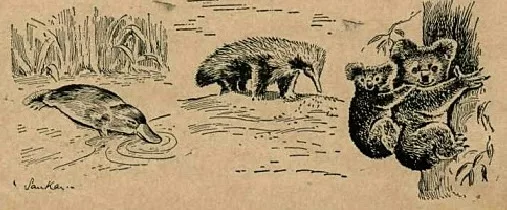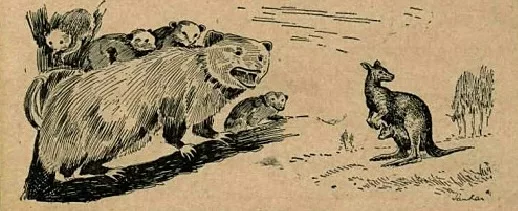Some Strange Mammals
Some types of mammals that have become extinct over the rest of the world still exist in Australia. These types became extinct in the rest of the world because of competition with more advanced classes. But Australia, surrounded by the sea, preserved them from such competition. We shall learn about four mammals.
One of them is the duckbill. As its name suggests, it has a bill like a duck but a fur over its body like a mammal. It resembles a duck in that it lays eggs (unlike a mammal) and has webbed feet. It can dig with its beak worms and shellfish out of the mud at the bottom of streams. It lives in burrows made in the banks of streams. The hole is maybe 30 feet long. It lays from one to three eggs at a time. When they are hatched, the young duckbills take nourishment from the mother. Male duckbills carry spurs on their hind legs. The catalysts have poison, making the duckbill the only poisonous mammal.
Echidna is another strange mammal that lays eggs. Immediately after laying, it puts the eggs in its pouch. The pouch can carry two eggs at a time. After hatching, the young remain in the bag for a few weeks. The echidna has spines on its body instead of fur. It eats ants, and its mouth and tongue are long to get at them.

The koalas and Kangaroo have pouches but do not lay eggs. They give birth to young ones who do not attain their actual shape until after some weeks of life in their mother’s pouch. Even when they emerge out of the bag, they may seek its protection when faced with danger.
The Koala is an Australian native bear. It lives on trees and eats mainly the leaves of eucalyptus trees. For three months, the young live in the mother’s pouch, and for several months more, they ride on the mother’s back. The mother can climb trees and leap with the young on her back. These creatures sleep during the day.
The young Kangaroo rides in the mother’s pouch. Seeing that the Kangaroo can leap across a distance of 25 feet, the rides must be pretty thrilling to the young Kangaroo!
North America has one strange mammal-the opossum. It, too, keeps its young in a pouch. But it may have as many as 15 young at a time. The young opossum, too, rides its mother’s back. It is not known how this primitive mammal managed to survive in North America.
